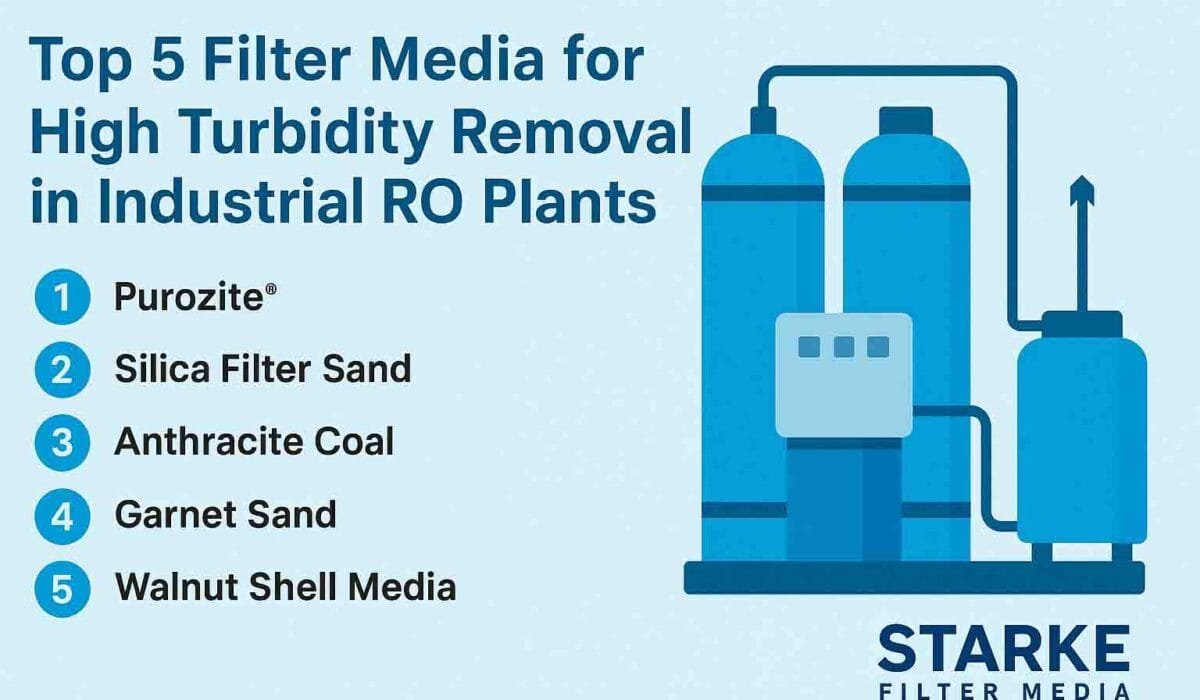Why Turbidity Removal Is Essential in RO Systems
Reverse osmosis (RO) membranes are highly sensitive to suspended solids and colloidal matter. High turbidity and TSS (Total Suspended Solids) can:
Clog membranes
Increase SDI (Silt Density Index)
Reduce permeate flow
Shorten membrane life
Increase cleaning frequency and operating costs
The right filtration media can drastically improve RO performance.
What Is Considered High Turbidity?
| Water Source | Typical Turbidity (NTU) |
|---|---|
| Raw river/lake water | 20–100 NTU |
| Borewell water | 2–10 NTU |
| Treated RO feed | <1 NTU (target) |
For RO pre-treatment, the target is <1 NTU and SDI <3.
Top 5 Filter Media for High Turbidity Removal
1. Purozite® (Advanced Zeolite)
Uniform particle size (0.6–1.2 mm)
High surface area
Dual-action: mechanical filtration + cation exchange
Removes suspended solids, colloids, iron particles
Lower backwash frequency than sand
Best for replacing sand in pressure filters
2. Silica Filter Sand
Cost-effective media for turbidity reduction
Works well as the base layer or in dual-media setups
AWWA B100 compliant
Ideal size: 0.6–1.0 mm
Needs frequent backwash in high turbidity applications
3. Anthracite Coal
Lightweight and coarse-grained
Allows deep bed penetration of particulates
High dirt holding capacity
Used as top layer in multi-media filters
Reduces head loss, improves filtration run time
4. Garnet Sand
High specific gravity (SG 4.0)
Placed at the bottom layer of multimedia beds
Captures fine particulates missed by upper layers
Low UC value ensures tight packing
Especially useful in 3-layer or 4-layer filters
5. Walnut Shell Media
Natural organic media with oil adsorption properties
Used where turbidity includes emulsified oils
Washable and reusable (up to 5 years)
Often used in STP/ETP and oily waste pre-treatment
A smart choice for textile, oil & gas industries
Suggested Multi-Layer Bed Design for High-Turbidity Applications
| Layer | Media | Size (mm) | Thickness (mm) |
|---|---|---|---|
| 1 | Anthracite | 0.8–1.4 | 300 mm |
| 2 | Purozite | 0.6–1.2 | 300 mm |
| 3 | Filter Sand | 0.6–1.0 | 250 mm |
| 4 | Garnet | 0.3–0.6 | 150 mm |
| 5 | Gravel Layers | 2–6 | 100–200 mm |
Total bed height = 1000–1200 mm
Flow Rate = 10–15 m/hr
Backwash = Every 7–10 days (or pressure drop >0.5 bar)
Real-World Example
Industry: Pharma RO Plant
Raw Water: Borewell + softened
Turbidity: 5.4 NTU
After Purozite filter: 0.65 NTU
SDI reduced from 6.8 to 2.2
Backwash: Every 10 days
Result: Increased RO membrane life from 14 months to 27 months
How to Choose the Right Media for Your Plant
| Condition | Recommended Media |
|---|---|
| High TSS + Iron | Purozite + Mno2 + Garnet |
| Surface water turbidity | Anthracite + Sand |
| Emulsified oil contamination | Walnut Shell |
| Need for compact footprint | Purozite (standalone) |
| Layered filtration required | Multi-media (Anthracite + Sand + Garnet) |
Why Choose Starke Filter Media?
✅ Uniform particle size & high purity
✅ AWWA B100 compliant media
✅ Technical support for filter sizing
✅ Customized multi-media packing
✅ Stock availability for fast delivery
Available in 25 kg & 50 kg bags. Bulk packing on request.
Frequently Asked Questions
Q1. Can I mix different media layers myself?
Yes, but correct layering is critical. Starke offers pre-layered media packs on request.
Q2. What is the ideal pressure drop across media?
0.2 to 0.5 bar. Anything beyond indicates need for backwash.
Q3. Can I use Purozite instead of sand?
Absolutely. It provides higher flow rate, lower clogging, and longer life.
Q4. Will these media reduce SDI?
Yes. Especially Purozite and Anthracite reduce SDI effectively when used in a proper filter design.
Want to improve RO membrane life and water clarity?
Talk to our engineers to select the best filter media for your turbidity challenges.
Email: info@starkefiltermedia.com
Website: www.starkefiltermedia.com

